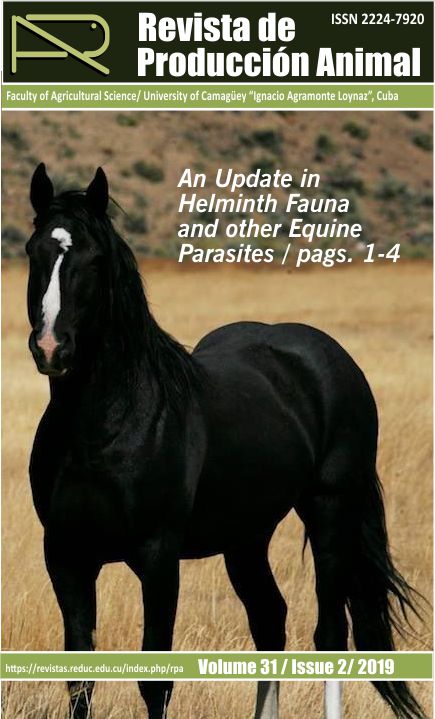An Update in Helminth Fauna and Other Equine Parasites in Cuba
Resumen
Understanding of parasitic diseases begins by knowing the species of a population. Accordingly, information to identify the equine helminth faunas of Cuba was re-collected due to the gradual loss of data caused by deterioration of the printed scientific literature. These parasitic populations were first identified by Doctor Idelfonso Pérez Vigueras during the first half of the 21st Century. Further studies were conducted on horse populations in different provinces. Currently, 34 helminths have been properly reported, including nine benzimidazole-resistant species of cyathostomes in several herds. As a result of a large number of nematodes described in the international scientific literature, and due to the insufficient studies made in Cuba, the equine helminth faunas probably include a larger number of species. Hence, further comprehensive studies should be conducted on this topic.
Descargas
Citas
Aromaa, M.; Hautala, K.; Oksanen, A.; Sukura, A. y Näreaho, A. (2018). Parasite Infections and their Risk Factors in Foals and Young Horses in Finland. Veterinary Parasitology: Regional Studies and Reports, 12, 35-38.
Díaz-Sánchez, A. A.; Pires, M. S.; Estrada, C. Y.; Cañizares, E. V.; del Castillo Domínguez, S. L.; Cabezas-Cruz, A. et al. (2018). First Molecular Evidence of Babesia caballi and Theileria equi Infections in Horses in Cuba. Par-asitology research, 117(10), 3109-3118.
Duarte, P. C.; Hill, A. E. y Morley, P. S. (2014). Epidemiology of Equine Infectious Disease. En D. C. Sellon y M. T. Long (Eds.), Equine Infectious Diseases (Second Edition, Chapter 61, pp. 515-529.e512). St. Louis: W.B. Saun-ders.
Espaine, L. y Lines, R. (1996). Manual de Parasitología y Enfermedades Parasitarias (Vol. II). La Habana, Cuba: Ed. Félix Varela.
Hernández, M. y Brito, H. (2011). Intensidad y extensión de Anoplocephala perfoliata en una empresa ganadera. Revista de Producción Animal, 23(1), 39-40.
Lichtenfels, J. R.; Kharchenko, V. A. y Dvojnos, G. M. (2008). Illustrated Identification Keys to Strongylid Parasites (Strongylidae: Nematoda) of horses, zebras and asses (Equidae). Vet Parasitol, 156(1-2), 4-161.
Matthews, J. B. (2014). Anthelmintic Resistance in Equine Nematodes. International Journal for Parasitology: Drugs and Drug Resistance, 4(3), 310-315.
Nielsen, M. K. (2012). Sustainable equine parasite control: perspectives and research needs. Veterinary Parasitolo-gy, 185(1), 32-44.
Nielsen, M. K. (2015). Internal Parasite Screening and Control. In K. A. Robinson & S. Edward (Eds.), Robinson's Current Therapy in Equine Medicine (Seventh Edition) (pp. 336-340). St. Louis: W.B. Saunders.
Pérez-Vigueras, I. (1936). Notas sobre la fauna parasitológica de Cuba Memorias de la Sociedad Cubana de Histo-ria Natural (Vol. 10): Universidad de la Habana.
Prieto, R., & Orta, T. (1977). Dos nuevos Cestodos para la fauna helmintológica de los equinos de Cuba. Poey-ana(167), 1-6.
Salas-Romero, J. (2018). Resistencia de los ciatostomas a los benzimidazoles en equinos de Cuba. (PhD Thesis), Ag-ricultural University of Havana, Cuba.
Salas-Romero, J., Batista, B., Villavicencio, L., Mencho, J. D., & Llorens, Y. G. (2014a). Prevalencia de nematodos gastrointestinales en la unidad equina Las criollas Rancho La Belén. Revista de Producción Animal, 26(3), 30-35.
Salas-Romero, J., Gomez-Cabrera, K., Chicoy, Y., Yero, J. C., Valle, E., Salas, J. E., & Arenal, A. (2017a). Especies de Ciatostomas Resistentes al Albendazol en Equinos, Cuba. Rev Inv Vet Perú, 28.
Salas-Romero, J., Gómez-Cabrera, K. A., Aguilera-Valle, L. A., Bertot, J. A., Salas, J. E., Arenal, A., & Nielsen, M. K. (2017b). Helminth egg excretion in horses kept under tropical conditions—Prevalence, distribution and risk fac-tors. Veterinary Parasitology, 243, 256–259.
Salas-Romero, J., Gómez-Cabrera, K. A., Salas, J. E., Vázquez, R., Arenal, A., & Nielsen, M. K. (2018). First report of anthelmintic resistance of equine cyathostomins in Cuba. Veterinary Parasitology: Regional Studies and Re-ports, 13, 220-223.
Salas-Romero, J., Mencho, J. D., Guerra, Y., & Mencho, J. C. (2014b). Prevalencia de nematodos intestinales y efi-cacia de Labiomec® en caballos de Camagüey, Cuba. Revista de Salud Animal, 36(3), 152-158.
Stancampiano, L., Usai, F., Marigo, A., & Rinnovati, R. (2017). Are small strongyles (Cyathostominae) involved in horse colic occurrence? Veterinary Parasitology, 247, 33-36.
Thamsborg, S. M., Leifsson, P. S., Grondahl, C., Larsen, M., & Nansen, P. (1998). Impact of mixed strongyle infec-tions in foals after one month on pasture. Equine Vet J, 30(3), 240-245.
Varus, V., & Valle, M. T. (1966). Nuevos registros de nematodos que parasitan en caballos (Equus caballus Linné) de Cuba. Poeyana, serie A (27), 1-10.
Los autores de los artículos publicados en RPA retienen los derechos de autor de su trabajo, de marca y patente, y también sobre cualquier proceso o procedimiento descrito en el artículo, así como a compartir, copiar, distribuir, ejecutar y comunicar públicamente el artículo publicado en la RPA o cualquier parte de aquel siempre que indiquen la fuente de publicación (autores del trabajo, revista, volumen, número y fecha), pero están de acuerdo en que la revista publique los trabajos bajo una licencia Creative Commons.
![]() Licencia Attribution-NonCommercial 4.0 International (CC BY-NC 4.0)
Licencia Attribution-NonCommercial 4.0 International (CC BY-NC 4.0)






































